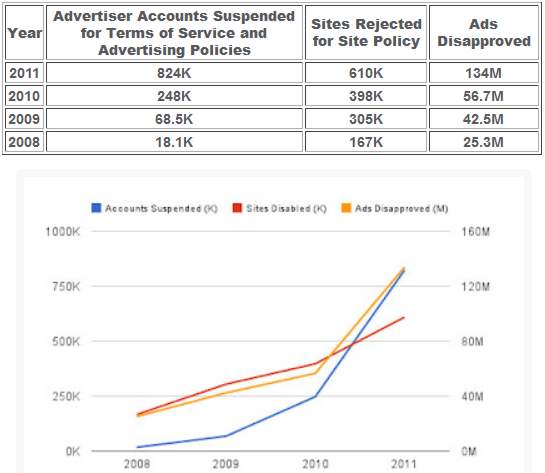| Google's Ongoing Campaign Against Scam Ads |
| Written by Janet Swift | |||
| Tuesday, 29 May 2012 | |||
|
Google has posted some facts and figures about its progress in preventing bad ads from displaying on its own site and on its AdSense partner sites. Google understands the negative impact of ads that make misleading claims or are spam or malware and wages a continuous fight against those who try to subvert its policies. Not only does it ban the adverts that are in violation, where it detects repeat offenders it also bans the advertisers- and in the case of ads promoting counterfeit goods the advertiser is normally banned after only one violation. The scale of the problem is increasing as shown in this table and graph. Notice that there are two scales in operation on the graph - the number of ads disapproved (the yellow line) is measured in millions whereas the number of sites disabled (the red line) and the number of accounts suspended (the blue line) are measured in thousands - so the impression that the blue and yellow lines are converging in 2011 is an artifact of scale and in fact there were over 160 times as many ads disapproved as sites that were sites suspended:
(click on chart to enlarge)
Google uses a combination of technology and manual review to detect and remove harmful and suspicious ads, according to David Baker, Google's head of ads policy engineering in this short video:
According to David's recent blog post, one factor in the recent success of eliminating bad ads, which led to a 50% reduction between 2010 and 2011, is the use of feedback from human raters to calibrate the automated systems.
More InformationMaking our ads better for everyone Related ArticlesGoogle Advertising Tools 2nd Ed (Book Review) Using Google AdWords and AdSense (Book Review)
To be informed about new articles on I Programmer, install the I Programmer Toolbar, subscribe to the RSS feed, follow us on, Twitter, Facebook, Google+ or Linkedin, or sign up for our weekly newsletter.
Comments
or email your comment to: comments@i-programmer.info |
|||
| Last Updated ( Tuesday, 29 May 2012 ) |




